 United Kingdom (1916-22), 8 light cruisers
United Kingdom (1916-22), 8 light cruisersHMS Danae, Dauntless, Dragon, Delhi, Dunedin, Durban, Despatch, Diomede.
WW1 RN Cruisers
Blake class | Edgar class | Powerful class | Diadem class | Cressy class | Drake class | Monmouth class | Devonshire class | Duke of Edinburgh class | Warrior class | Minotaur classIris class | Leander class | Mersey class | Marathon class | Apollo class | Astraea class | Eclipse class | Arrogant class | Highflyer class
Pearl class | Pelorus class | Gem class | Forward class | Boadicea class | Blonde class | Active class | Bristol class | Weymouth class | Chatham class | Birmingham class | Birkenhead class | Arethusa class | Caroline class | Calliope class | Cambrian class | Centaur class | Caledon class | Ceres class | Carlisle class | Danae class | Cavendish class | Emerald class
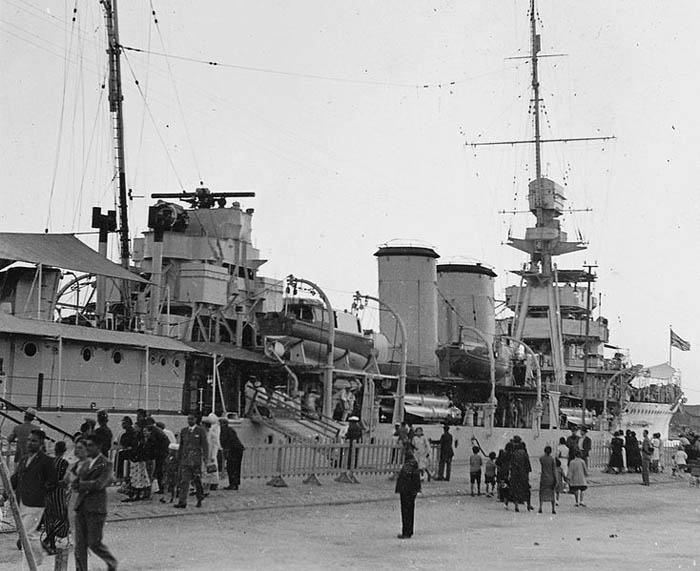
HMS DELHI in bulgaria, during the interwar
The Danae class were the last large WW1 British light cruiser serie, also called “D” class to distinguish them from the “C class” they replaced, or the following “E” class which construction was only partially realized (HMS Enterprise and Emerald). They were basically larger C class with an extra main gun. Started in 1916 to 1918, they were completed too late for most to take part in WWI: Only Danae and Dragon saw little service at the end of the war. However, they all served in the interwar, and were often modernized soon before WW2 commenced, and afterwards, notably as AA cruisers, spending the war as escorts. One was sunk, two expanded as breakwater off Normandy beach in 1944.
The Danae class, the “improved Ceres”.
In September 1916 three Improved Ceres class were ordered, taking the original Arethusa concept to its limit. As before, the hull was lengthened to enable an extra main gun to be fitted in between the foremast and the fore funnel. The reason was an erroneous intelligence report which suggested that new powerful German light cruisers were planned. The result was effective, but the long asymmetrical profile had nothing of the balance of the C classes. As their beam was increased they were also able to accommodate triple torpedo tubes, while ammunition reserve were augmented by 20%, torpedo stock by 50%.
In July 1917, a further three were ordered (2nd Group – Delhi, Dunedin and Durban), followed by six more in March 1918, but the last four were cancelled (Daedalus, Daring, Desperate, Dryad) on 26 November 1918. All the later group were modified like the Capetown class, with trawler bows for better seakeeping. In addition, several had a conspicuous hangar abaft ‘R’ gun, which was later removed. HMS Diomede had an experimental enclosed gunhouse for ‘A’ gun with 40° elevation as an “anti-zeppelin” gun.
In 1920, it was proposed to complete Despatch as a royal yacht, her armament deleted and two boilers removed to reduce speed to 24kts. Her forecastle deck would have been extended right aft, and the bow and stern would have been altered to resemble a yacht. Nothing came of this scheme.
Development history
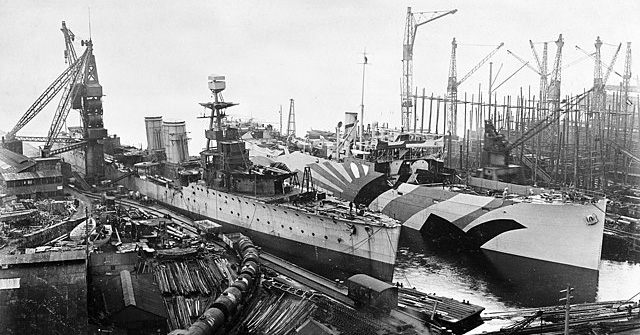
HMS Dragon built 1918 close tanker War Angler Scotts Yard, Greenock
Based on partly correct intel about a new class of very powerful German light cruisers class in construction (Possibly the Cöln class, 7500 tons FL, 27.5 kts, eight 15 cm guns), the admiralty decided that the C class were sub-par and wanted a larger class, armed with six main guns. Therefore, the “D” class, or Danae, were based on the preceding C class to gain development time, just lengthened by 20 feet (6 m) in order to accomodate a sixth 6-inch (152 mm) gun, placed in between the bridge and forefunnel in a position only suitable to broadsides. The four others were still in the centerline.
This new configuration saw and ‘A’, ‘B’ positions forward, superfiring, then a new ‘P’ in between the bridge and fore funnel, ‘Q’ aft of the second funnel, the ‘X’, ‘Y’ aft, with the first superfiring. Also with the extra beam gained, twin torpedo banks now could be replaced by triple banks, so making for a six tubes broadside, twelve tubes in all, which at the time was the heaviest torpedo armament ever mounted on a cruiser.
The improved Group B (Delhi class) was beamier and counted also Dunedin, Diomede, Durban and Despatch, but also Daedalus (to be laid down in Armstrong, Elswick in 1918, cancelled 26.11.1918), HMS Daring (at Beardmore, Dalmuir), HMS Desperate (to Hawthorn Leslie, Hebburn) and HMS Dryad (in Vickers, Barrow). They were axed at the end of the war.
Design
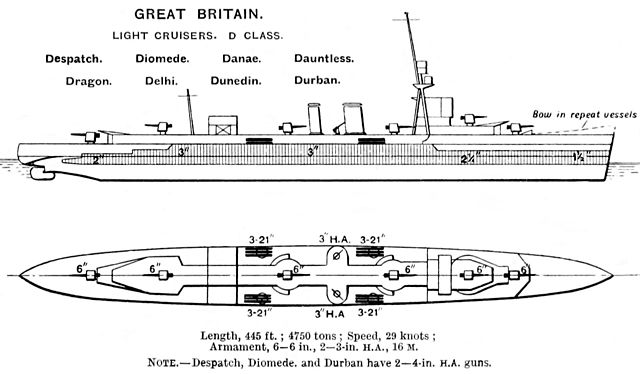
The general design scheme followed the last C-class cruisers, notably the Ceres class, but with a stretched hull, lengthened by 20 feet (6 m). Where the latter displaced around 4,180-4,950 tons FL, the D class reached 4,850 tons standard and 5,925 tons fully loaded, so almost a 1,000 ton increase, or 1/5 tonnage augmentation. The greater span between light and fully loaded displacement were explained by a larger stotage capacity for ammunitions and fuel as well.
They measured 445 ft (135.6 m) between perpendiculars, and 472.5 ft overall, versus 450 feets for the previous ships (144 verus 137 m) but not larger (43 feets or 12 m) until the Despatch and Diomedes benefited from that increase to 46.5 ft (14.2 m) (47 ft (14 m) in order to improve stability and plan for future upgrades.
Also to gain time, engineers were told to retake the machinery and general layout of the Ceres group, the last one of the C-class. It had indeed improvements in ASW protection in its compartimentation. However, HMS Danae, Dauntless and Dragon had the standard bow design, whereas the remainder adopted the same improved bow of the Capetown group (very last C class cruisers). This famous trademark called the “knuckled bow” had a recessed part acting as a wave breaker to prevent water spray to reach the upper deck.

HMS Diomede, Panama Canal, top view, showing the forward “semi-turret”
Indeed this was adopted after the C class were recoignised very wet forwards. The Capetowns sheer was increased forward with this knuckled “trawler bow”, which was soon found very successful and spread in all cruiser constructions until the end of WW2 (But HMS Birmingham in 1935). HMS Despatch and Diomede also differed from the pack (Laid down summer 1918) with their beam increased by ½ foot for a better stability.
HMS Despatch and Diomede received also at completion a 4 inch anti-aircraft gun rather than the 12 pounder (3 inch/75 mm) Vickers guns adopted on the others. HMS Diomede in addition tested on her very wet ‘A’ gun position a weatherproof housing for her CP Mark XVI, better protecting the gun crew, but it was still not a proper turret. In addition to the sixth main gun, additional torpedo tubes were installed and depth charge throwers were also included.
Protection
Although the general same scheme of the Ceres class was retaken, with comparable, but increased figures overall, lessons of the Battle of Jutland were applied, so protection was overall improved, and in detail. The forward Mk XII 6-inch gun was experimentally fitted on HMS Diomede with a prototype gun house allowing greater elevation which was a frank success. The belt was still protected by only 3(inches at best for the amidship (central) section, but extra strays were added for the upper and main decks over sensible locations, like the machinery and steering gear.
- Main belt: 1.5–2.25 in (38–57 mm) forward
- Main belt: 3 in (76 mm) amidships
- Main belt: 2.25–2 in (57–51 mm) aft
- Upper deck armor: 1 in (25 mm) over machinery
- Main deck armor: 1 in over steering gear
- Gunshields: 1 in
- Conning Tower: 3 in (76 mm)
Powerplant
This was basically a repeat of the previous class, and consisted in 2 sets of Brown-Curtis geared steam turbines, coupled with 6 Yarrow oil-fired boilers. However the Dauntless and Diomede differed in having two sets of Parsons geared steam turbines, but still six Yarrow boilers, for 40,000 shp (30,000 kW) total. This enabled a top speed of 29 knots (54 km/h; 33 mph) on trials, 27 knots fully loaded, versus 28.5 on the C-class. The greater lenght and displacement in fact favored speed instead of capping it, due to the greater wavelenght. The ships were less sensible to motion in heavy weather. All carried 1,050 tons of oil, enough for 5,000 nautical miles (15 kts), or 2,300 nmi (4,260 km) at 27 knots (50.0 km/h), compared to the C-class 5,900 nautical miles (10,900 km; 6,800 mi) at 10 knots (19 km/h; 12 mph).
Armament
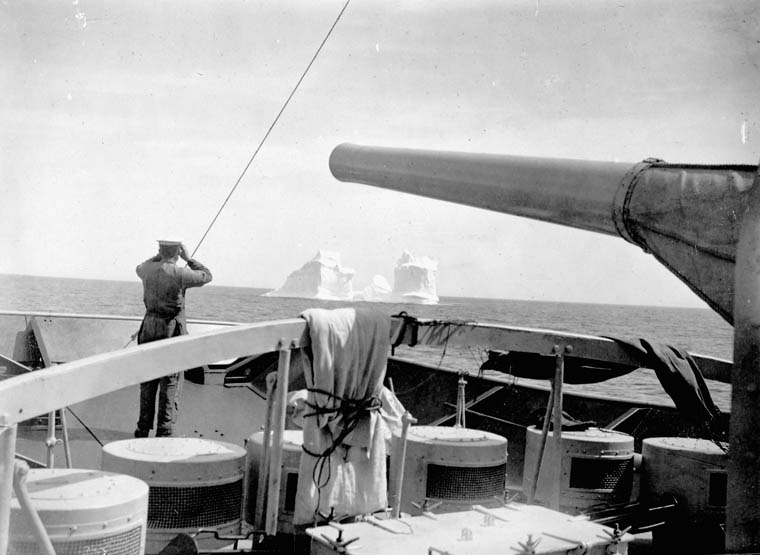
Main guns of HMS Dragon as she carried the Prince of Wales to Canada, 1919
Main: BL 6-inch (152.4 mm) L/45 Mark XII guns
The last generation of the standard-issue 6-in in the British Royal Navy in WWI, by Vickers-Armstrong Elswick. They were all placed on single mountings CP Mark XIV with small shields, opened to aft to allow the gun crew to operate, and offering some protection against shrapnel. HMS Diomede differed by having her ‘A’ mount using the CP Mk.XVI experimental gunhouse (a fully enclosed turret), offering better protection as well, from shrapnel and elements since this was the most exposed, on the forecastle deck.
Secondary: QF 3 inch 20 cwt L/45 Mk.I
Two 3 inch 20 cwt L/45 Mk.I (76 mm) were placed on mounts HA Mk.II for AA defence. They were installed on the wings amidship of the two funnels. These were standard-issue guns, produced until 1947 in their last Marks. They used a semi-automatic sliding-block, and hydro spring, constant recoil. They could elevate to 90°. Muzzle velocity was 2,000-2,500 ft/s (760 m/s) depending on the shell, range 16,000 ft-23,500 ft (7,200 m).
Tertiary: QF 2-pounder L/39 Mk.II
The 2-pdr were pure rapid-fire AA guns designed in 1917, the famous “pompom”. They were placed on mounts HA Mk.II installed aft, on the quarterdeck superstructure in front of ‘X’ gun, in echelon. They and reached 115 rpm, fed by 14-rds steel link belt, and reach 3,960 m (13,300 ft) in A/A ceiling, 6,220 m (6,800 yd) at 701 m/s (2,300 ft/s) max range.
Torpedoes: 4×3 21-in TT Banks
The strong point of the design compared to the C-class. With their greater lenght, the Danae class cold accomodate four banks instead of just two per side. This made them the most powerfully torpedo-armed cruisers in the world at that time. These four triple tubes banks were placed at the greatest beam amidship on deck, two abreast the ‘C’ gun and forre funnel, and a pair aft of ‘D’ gun. They fired 21-inch (533 mm) torpedoes, standard-issue 21″ (53.3 cm) Mark IV or Mark IV* torpedoes. Designed 1912, these weighted 3,206 lbs (1,454 kg), were 22 ft 7.5 in (6.896 m) long, carrying a 515 lbs. (234 kg) TNT warhead at three settings: 8,000 yards (7,300 m)/35 knots, 10,000 yards (9,150 m)/29 knots, 13,500 yards (12,350 m)/25 knots.
Aircraft tests 1918-1922
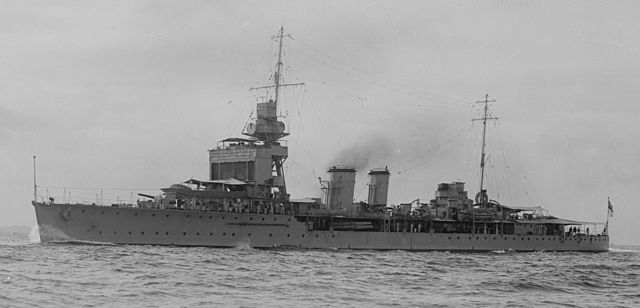
HMS Dragon’s massive bridge hangar in the 1920s. SLV Allan Green
HMS Dragon and Dauntless (Laid down January 1917) were completed with a hangar for a floatplane, built into the bridge forward, and a compass platform was installed on top of the forward superstructure, over ‘B’ gun. HMS Delhi, Dunedin, Durban, Despatch and Diomede all received a flying-off platform aft. These aircraft received wheeltrains and were to be launched full-throttle, with a crew blocking the wheels. The platforms had a slight decline so to increase speed, but these were still freightfully short anyway. The Sopwith Camels or Pup which took off in a mere 20 meters or so needed the full participation of the cruiser, which took the best possible position into the wind for the launch.
Modifications
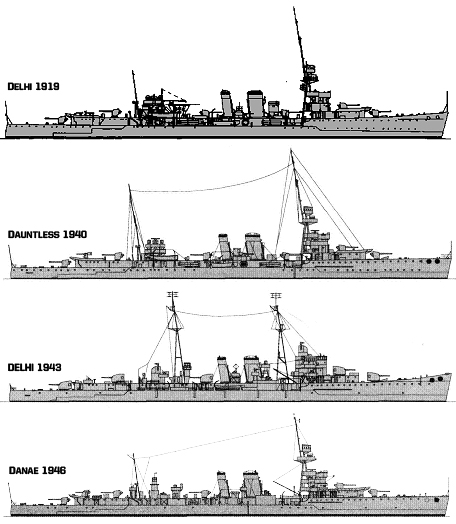
D-class various appearance in 1919 and 1940, 1943 and 1946
In the 1920s, Danae, Dragon, Dauntless had a flying-off platform, installed in 1918 with a hangar forward removed. Diomede, Despatch had a single 102mm/45 QF Mk V installed aft (on the quarterdeck roof, superposed to the after deck turret). Soon after, Danae, Dauntless, Dragon, Delhi, Dunedin and Durban received two 76mm/45 AA and three 102mm/45 QF Mk V DP guns.
Before the war, in 1938-1939 Despatch and Dunedin received two single 40mm/39 Bofors and two two quad 12.7mm/62 (Vickers .5 in HMG). After the war in October, Danae received two 2pdr QF Mk VIII AA guns. HMS Delhi as emerging from New York NyD in December 1941 had now a completely new US-pattern armament, with five five 127mm/38 Mk 12 main guns in single turrets where her former guns were, and two quad 40mm/39 2pdr QF Mk VIII AA guns, then eight 20mm/70 Oerlikon Mk II/IV AA guns, and a full displacement now to 6500t, with 200t of solid ballast to avoid stability issues.
In early 1942 Delhi also received in UK a full electronics radar suite, with the navigation and air warning type 271, type 281, two FCS type 282 and two type 285 radars. Danae also at the same time received an extra 102mm/45 gun aft and a quad 40mm/39 2pdr “pom pom” QF Mk VIII AA, then Dauntless and later in the summer HMS Despatch both received eight single 20mm/70 Oerlikon Mk II/IV AA guns together with a type 271 and type 286 radars. In August Durban also received the same upgrade and in late 1942, Danae was given a quad Bofors and an extra 102mm/45 QF Mk V DP gun.
1943 saw Danae receiving a new armament, with just al but one of her 152mm/45 (6 in) guns removed, and three 102mm/45 DP guns fitted instead, and a quad 40mm/39 AA, two triple banks removed and another twin 102/45 QF Mk XVI installed and a second quad 40mm/39 2pdr Pompom QF Mk VIII, four twin 20mm/70 Oerlikon Mk II/IV and the type 271, type 282, type 283, type 291 radars. HMS Dauntless received an extra two single 4-in (102/45) DP guns and two quad 40mm/39 2pdr QF Mk VIII pompom, then HMS Delhi had two extra single and two twin 20mm/70 Oerlikon Mk II/IV AA guns.
In June, Diomede received also an extra 102mm/45, two single, and a quad 2pdr QF Mk VIII pompom and eight single 20mm/70 Oerlikon Mk II/IV plus the type 273 and type 291 radars. Diomede later that year obtained two more single and two twin 20mm/70 Oerlikon and Dauntless a type 273 radar.

HMS Delhi off Vancouver in the interwar
1944 saw HMS Delhi fitted with two extra twin 20mm/70 Oerlikon Mk II/IV and a type 650 ECM suite and both Dauntless Diomede had all their TTs removed. No modification was made in 1945, but after the war, they receoive extensive armament refits in January 1946: Danae had all five 152/45 CP Mk XIV guns and twin 4-in Mk XIX, two quad 40mm/39 Mk VII, four twin 20mm/70 Mk V and the type 271, type 282, type 283, type 291 radars. Dauntless had all her six 152/45 CP Mk XIV guns in place and a single mount 102mm/45 HA Mk III, two quad 40mm/39 Mk VII, two single 40mm/39 HA Mk II, eight oerlikon and a new radar suite with the type 271, type 273, type 286 radars. This was about the same for Diomede but with the type 273 and type 290 radars only, on Delhi (Still with her five 127mm/38 Mk 30) the extensive radar suite comprising the type 271, type 281, 2x type 282, 2x type 285 radars, type 650 ECM suite. HMS Despatch was in “pure AA” mode, with just three single 102mm/45 HA Mk III, sixteen 40mm/60 Mk III and ten single 20mm/70 Mk III and the type 271 and type 286 radars.
Delhi served as the testbed as well. It was realized the British HACS and FKS AA fire control systems were not as good as the US ones, and while under modernization in Brooklyn NyD, the British asked to have installed the MK 37 Gun Fire Control System, as a test bed to serve the newly installed 5-inch/38 calibre guns. The British were quite impressed by the overall performances and this went through the Admiralty and back, requesting the US via lend-lease the provision of forty-two of such systems to be sent to the Royal Navy, fitted on newly developed cruisers, planned also on HMS Vanguard, new aircraft carriers, and the Battle-class destroyers, and these were carried out but war ended before 40 new systems could be delivered. The role of HMS delhi as a testbed for this has been recoignised as instrumental.

HMS Danae in 1920, old author’s illustration. More modern ones awaited.

ORP Dragon in 1944.
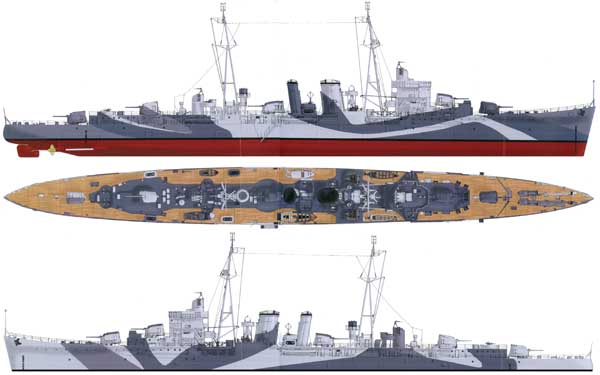
HMS Delhi in 1942, with her famous US pattern artillery.
⚙ Danae Group 1 specs (*group 2) |
|
| Dimensions | 144 x 13.2/14* x 4.4/4.5* m (472 x 46-47* x 16.5 feets) |
| Displacement | 4,850 tons standard, 5,925 tons Fully Loaded |
| Crew | 450/469 wartime |
| Propulsion | 2 shafts Parsons turbines, 6 Yarrow boilers, 40,000 hp. |
| Speed | 29 knots (42 km/h) |
| Range | 2300 nm @ 27 knots. |
| Armament | 6× 6-in/45 (152 mm), 2x 3-pdr/45 (57mm), 2x 2-Pdr/39 AA (40 mm), 4×3 21-in TTs (533mm) |
| Protection | Belt 1.5-2.25 in, decks 1 in, Masks 25 1 in, CT 3 in) |
Combat service records:
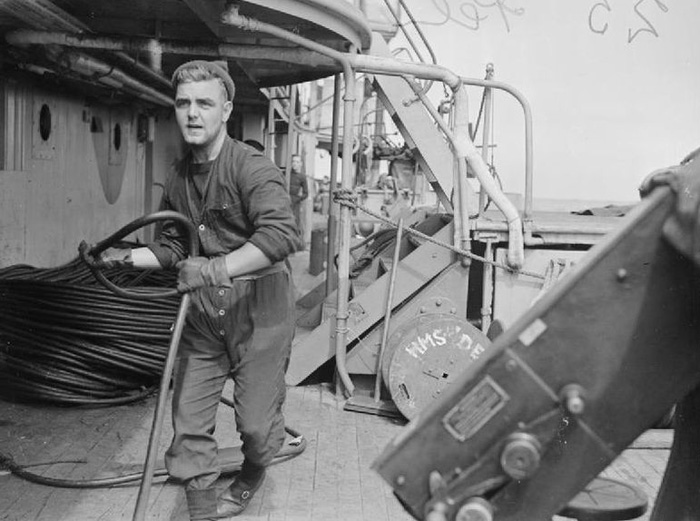
HMS Despatch during the Allied Invasion of Normandy, Near Arromanches, 6-8 June 1944
Danae joined 5th Light Cruiser Squadron. Harwich Force in June 1918, the first one of the class to see war service. She was in the Baltic 1919, then Ist LCS, Atlantic Fleet from September 1919. Served in Second World War; to Polish Navy as Conrad October 1944 and sold in 1948.
Despatch was to be launched 10 September 1919, but she was stuck on her way for two weeks Towed to Chatham DYd for completion and then joined Sth LCS, China Station from June 1922. Served in Second World War and sold in 1946, Dragon joined 5th LCS, Harwich Force in Augast 1918 and went to Baltic in 1919 before joining Ist LCS, tFleet. Part of escort for Prince of Wales’ visit to West Indies in August 1919. Served in Second World War and lent to Polish Navy in January 1943, and after torpedo damage scuttled as part of Mulberry Harbour in 1944.
Served in the Second World War, scuttled as part of the Mulherry H harbour breakwater in 1944. DYd for completion and joined 5th LCS, China Station in October 1922. Served in Sccond World War and
sold in 1946. Dunedin commissioned for Ist LCS, Atlantic Fleet October 1920 and transferred to RNZN May 1924-March 1937 (relieving Chatham). Served in Second World War and torpedoed off coast of Brazil by U 124 in 1941. Durban was towed to Devonport for completion and joined 5th LCS, China Station November 1921.
During WW2, Danae was transferred to the Polish Navy, as ORP Conrad, and served as such from 4 October 1944 to 28 September 1946, retroceded and sold for breaking up on 22 January 1948. Dauntless served most of her WW2 career in the Indian Ocean and Far east and was a TS from 1943, then reserve from February 1945.
Sources/read more
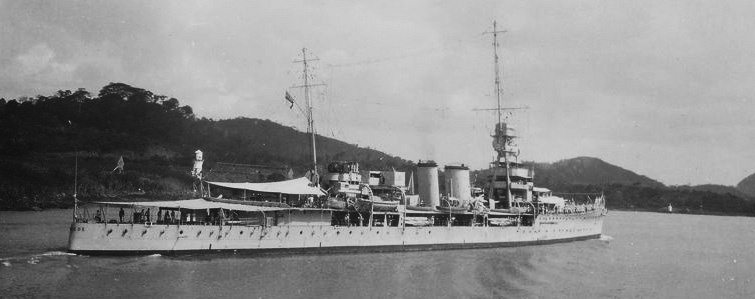
HMS Diomede, crossing Panama canal
Books
Jane’s Fighting Ships of World War One (1919), Jane’s Publishing Company
Conway’s all the world’s fighting ships 1906-1921 and 1922-1947
Campbell, N.J.M. (1980). “Great Britain”. In Conway’s All the World’s Fighting Ships 1922–1946.
Colledge, J. J.; Warlow, Ben (2006) [1969]. Ships of the Royal Navy: Complete Record, Chatham Publishing.
Friedman, Norman (2010). British Cruisers: Two World Wars and After. Seaforth Publishing.
Raven, Alan & Roberts, John (1980). British Cruisers of World War Two. Annapolis
Rohwer, Jürgen (2005). Chronology of the War at Sea 1939–1945: The Naval History of World War Two. Annapolis
Whitby, Michael (2020). “On Barren, Hideous Rocks: The Grounding of HMS Dauntless, July 1928”. Jordan, Osprey
Whitley, M. J. (1995). Cruisers of World War Two: An International Encyclopedia. Cassell.
Zolandez, Thomas (2004). “Question 6/01: Japanese WW II Spy”. Warship International.
Colledge, J. J.; Warlow, Ben (2006) [1969]. Ships of the Royal Navy: The Complete Record of all Fighting Ships of the Royal Navy, Chatham Publishing.
Friedman, Norman (2010). British Cruisers: Two World Wars and After. Seaforth Publishing
Gill, G. Hermon (1957). Royal Australian Navy 1939-1942. Australia in the War of 1939–1945.
“Taffrail” (Henry Taprell Dorling) (1973). Blue Star Line at War, 1939–45. London: W. Foulsham & Co
Rohwer, Jürgen (2005). Chronology of the War at Sea 1939–1945: The Naval History of World War Two, Naval Institute Press
Sites
The D class on navypedia
On worldwar1.co.uk
The Danae class (wiki)
Wikimedia commons photo database
About the Torpedoes on navweaps
Photo Gallery
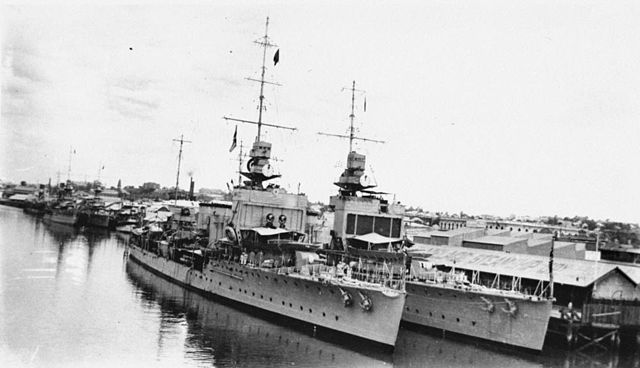
Four D-class cruisers at the south Brisbane wharves in 1924 during the Royal Navy world tour
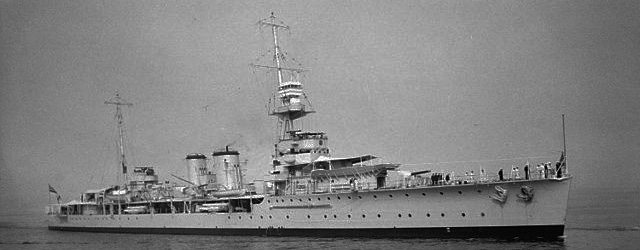
HMS Danae at Vancouver 1934
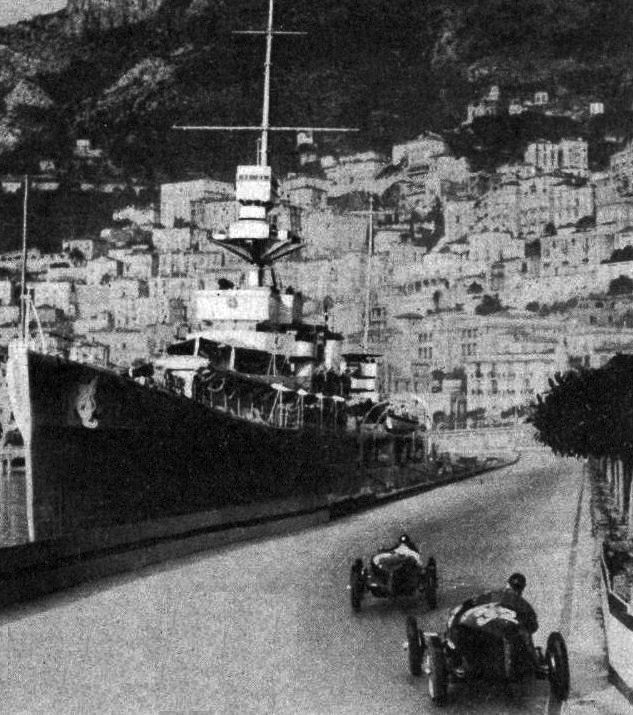
Grand Prix of Monaco, ace driver Taruffi passing in front of HMS Dehli
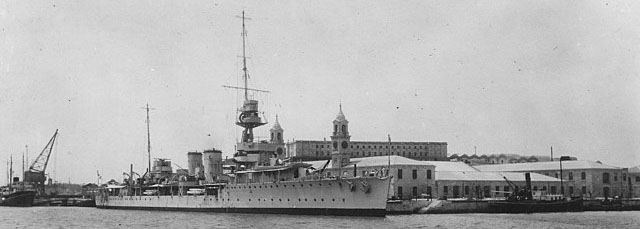
HMS Dauntless, Royal Naval Dockyard in Bermuda ca1930
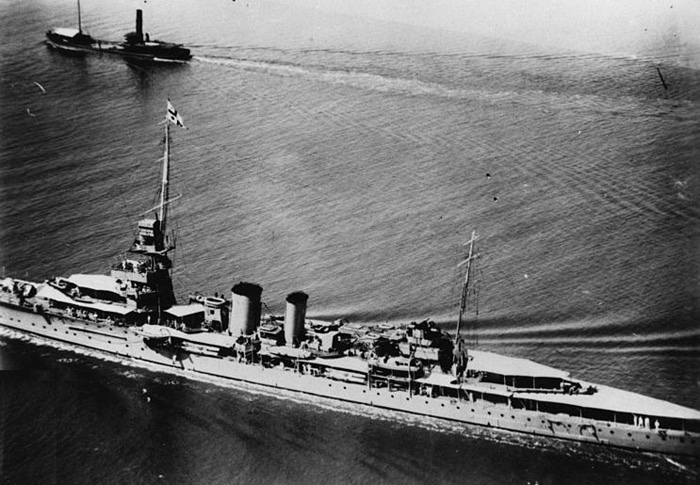
HMS Delhi off New Zealand
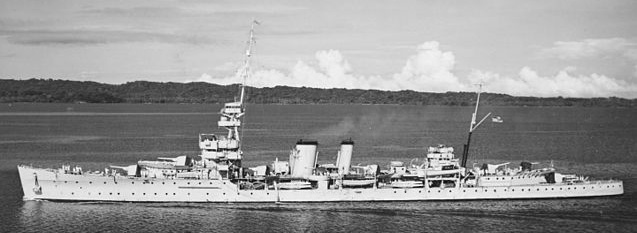
HMS Despatch underway off the Panama canal zone on 31 October 1939
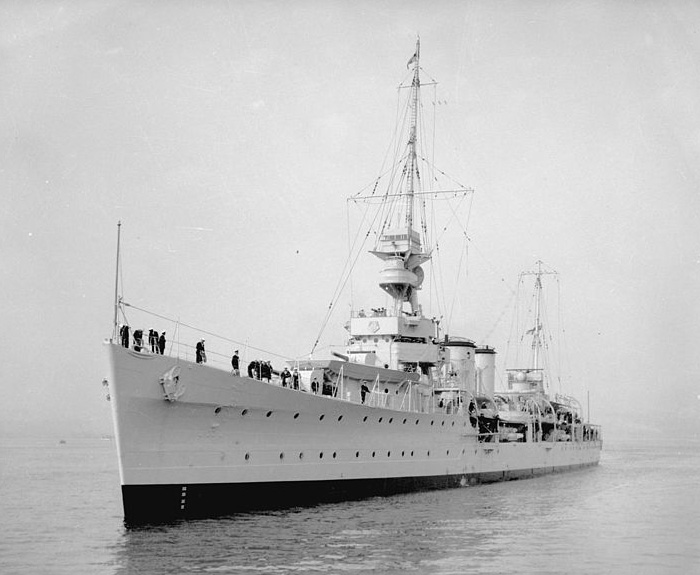
HMS Despatch, Vancouver 1928
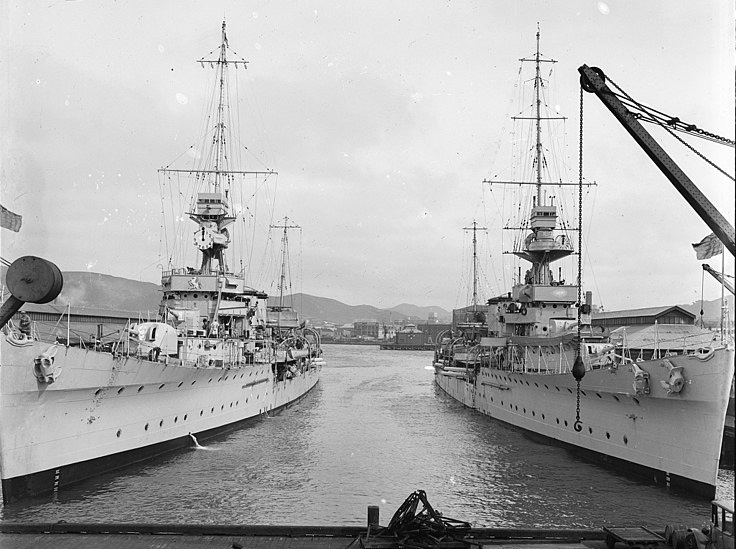
HMS Diomede and Dunedin in Wellington
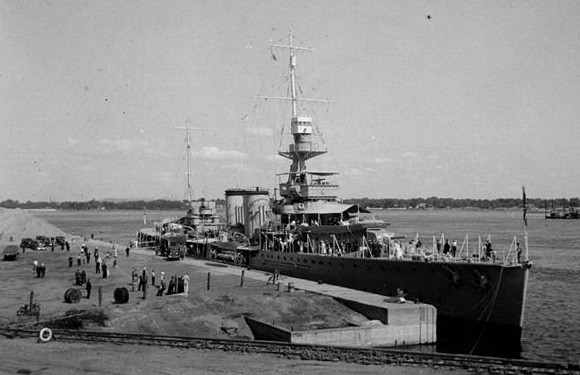
HMS Dragon, 5 October 1936

HMS Dragon at Vancouver, 1933
The models corner

Cruiser D Class O.R.P. Conrad, Niko Model 1:700
1/1800 tabletop game Shapeways model
The D class in action
 HMS Danae
HMS Danae

HMS Danae, August 1944
Launched on 26 January 1918, HMS Danae was the lead ship of the D class, and set records during her sea trials thanks to her 40,000 horsepower and 29 knots, still achieving 6,700 nautical miles on cruise speed. She was attached to the Harwich flottila (5th Light Cruiser Squadron) as soon as completed and commissioned on 22 July 1918. She took part in North Sea patrols as the war was ending, without noticeable event. In October-November 1919, like many other cruisers she was ordered to combat the Bolshevik threat and operate in the Baltic Sea, supporting the White Russians with HMS Dragon and Dauntless.
Interwar service
In February 1920, she joined the 1st Light Cruiser Squadron, Atlantic Fleet. In 1923, she was attached for a time to the “Special Service Squadron” a “public relations” flotilla where she escorted the battlecruisers HMS Hood, and Repulse and other cruisers of the class, HMS Delhi, Dragon, Dauntless and Dunedin plus destroyers sent on a world tour of goodwill visits and “showing the flag” around the globe, leaving Devonport on 27 November, then making it in Sierra Leone, Cape Town, Port Elizabeth, Durban, Zanzibar, Trincomalee, Singapore, Fremantle, Albany, Adelaide, Melbourne, Hobart, Sydney, Wellington, Suva, Samara, Honolulu, Victoria, Vancouver, San Francisco before a split from the the battlecruisers which headed for home via the Panama Canal. She visited Callao, Valparaiso and Talcahuano down to the Strait of Magallan, and then eastwards to the Falkland Islands, Bahia Blanca, Buenos Aires, Montevideo and Rio de Janeiro while proceeing to the Atlantic Ocean via Cape Verde Islands and heading back in turn for home.
Next, Danae was sent to the Mediterranean squadron where she served in 1927-1929 (1st Cruiser Squadron) before ordered back home for an overhault and modernisation. In 1930 she left Devonport for Bermuda on 20 August 1930, for Bermuda, assisting off Halifax the paddle-wheeled tug Sandboy, towing the tug to the port on Halifax on 2 September before joning the 8th Cruiser Squadron (America and West Indies Station) at the Bermuda Royal Naval Dockyard.
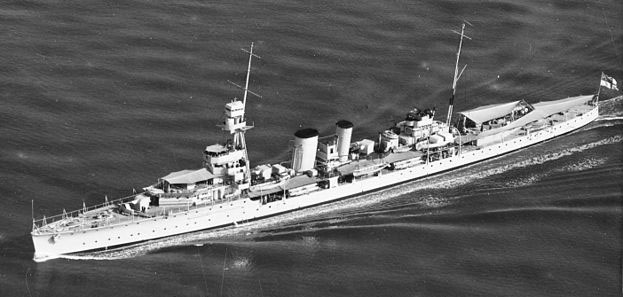
HMS Danae underway off San Diego on 29 June 1934
She was sent to aid Santo Domingo struck by a hurricane (10 September, escorting the oiler Serbol), helping the American Relief Committee with onboard medical supplies and surplus food. She next resumed her patrols between the Newfoundland to Cape Horn, making ventures in the Pacific Ocean on longer cruises. Bermuda was the meeting point of the fleet for exercises. Captain Eric Richard Bent took command in October. In 1935, with the Second Sino-Japanese War erupting she escorted evacuation convoys from Shanghai to Hong Kong. At this occasion she was fired at by the Japanese Navy, later refuted as an error. Northing much happened until 1939.
Wartime service
Leaving the Far East fleet, HMS Danae went to Great Britain, being placed in reserve due to her age. However she was mobilized in July 1939, and attached to the 9th Cruiser Squadron (South Atlantic, Indian Ocean stations), departing in October and by 23 March 1940 joining the Malaya Force. She patrolled the Dutch East Indies and Singapore. On 20 January, she joined the China Force as a convoy escort to the Yellow Sea, also linking the Dutch Indies and Ceylon with Durban, Dauntless, Cornwall and HMAS Canberra. On 24 February 1941, she was stationed in Batavia, and then Colombo, until ordered to Cape Town for an overhaul and modernization in mid-1942.
When this was over, in July 1943 (11 months) she started a refrsehr cruiser, training and then resumed escort missions. In March 1944 she returned home, attached to the 1st Cruiser Squadron and in May, as preparations for the Normandy landing went on, she was prepared to act as a support ships in the Sword Beach area. On June 6, she carried out her share of the feet bombardment at dawn, and proceeded with on-demand ground support missions? She notably shelled German positiions with HMS Ramillies, Warspite and the cruisers Mauritius, Frobisher, Arethusa and ORP Dragon (her sister ship in Polish service) plus a group of destroyers. Her misson accompished she left in July for Port en Bessin and Ouistreham to support other artillery support missions, until returning home in August. Placed in reserve for good, as her crew was needed on more modern vessels, she was hulked in Plymouth.
As ORP Conrad (1945)
After the loss of ORP Dragon however, on 4 October 1944, the admiralty decided to lease her as well, manned mostly by the surviving crew of ORP Dragon and under command of Stanisław Dzienisiewicz. She was overhauled and modernied for the last time in Southampton, Chatham, until 23 January 1945, initially to be named “ORP Wilno” or “Lwów”, seen too controversial as not to to offend the Soviets which recently captured these cities. Named ORP Conrad, (after Józef Konrad Korzeniowski -Joseph Conrad) she moved to Scapa in February 1945 and joined on 2 April the 10th Cruiser Squadron (Birmingham, Bellona, Diadem, Dido) for a short time. She was sent in drydock to repair her worn out and damaged turbine, only out on 30 May 1945, by which time the war was practically over. She served briefly with the 29th Destroyer Flotilla (destroyers Zodiac, Zephyr and Zest) aand after V-Day in Europe, sent to Wilhelmshaven captured by the Polish 1st Armoured Division.
She was used until the end of the year as a transport ship for the Polish Red Cross, between there and Norway, Denmark. In January 1946 she went for some training off Rosyth with the rest of the Polish Navy (ORP Burza, Błyskawica, Piorun, Garland) and on 8 March, all these vessels were decommissioned, the Polish crews transferring them to the RN before gradually departing. In August 1946 she had a skeleton crew as her transfer was completed in late September, renamed Danae and sent to the Care & Maintenance Party, Falmouth. On 22 January 1948, on disposal list in 1947, she was sold to Thos. W. Ward for scrapping.
 HMS Dauntless
HMS Dauntless
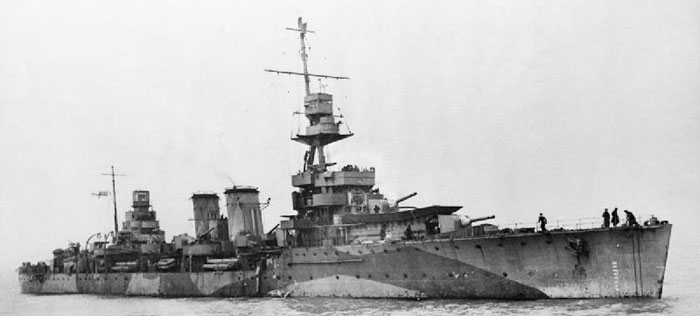
HMS Dauntless, April 1942, en route to UK for her refit.
HMS Dauntless was built at Palmers Shipbuilding and Iron Company, Jarrow, laid down 3 January 1917, launched 10 April 1918 but Commissioned only on 22 November 1918, too late to see action in the First World War.
Interwar service
After her shakedown cruiser and intensive training, she was assigned in 1919 to the Baltic Sea fleet for her first operational deployment, against the Bolshevik revolutionaries in Russia. Afterwards, she had a maintenance back home and was sent to the West Indies in detached service in 1921.
Afterwards, she was attached to the 1st Light Cruiser Squadron, Atlantic Fleet for five years. As a member of the Special Service Squadron cruising fleet (the ‘Empire Cruise’) she toured the world in 1923-1924, making many port called and goowill visits, dhowing the flag around the world. When done, Dauntless was reassigned to the Mediterranean Squadron for the years 1925-1927, also cruising yearly and making numerous port calls.
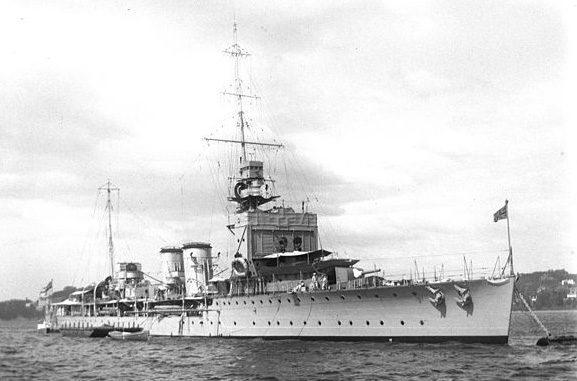
HMS DAUNTLESS 11 April 1924
In May 1928 she was recommissioned after an extensive overhaul, assigned to the North America/West Indies Stations and based at the Royal Naval Dockyard, Bermuda. She ran aground on 2 July 1928 on the Thrum Cap Shoal. It was 5 nautical miles (9.3 km) off Halifax (Nova Scotia), and this badly damaged her bottom. A breach soon flooded her engine room and one boiler room. While she was unable to free herself, her captain eventually ordered to abandon ship, only leaving onboard officers and a few able seamen. When inspected later it was decided to have her lightened. Subsequently all guns and torpedo tubes were removed and placed on barges equipped with cranes. All other equipments were removed, notably the ammunition, and her tanks were pumped dry. Then divers and engineers tried to patch her bottom and pumped her enough so she could be refloated and towed away on 11 July 1928, so after 9 days of frantic efforts. She was towed off by her sister ship HMS Despatch assisted by three tugs. She was repaired in Halifax on the remainder of 1928 and early 1929, reduced to the reserve.
In 1930, she was transferred to the America & West Indies Station. In 1931-1933 she served with the South American Division without noticeable event, and in 1934, relieved HMS Curlew on the Mediterranean station, reassigned to the 3rd Cruiser Squadron. In 1935, she was back home for a long crew leave, an overhaul, and be paid off into reserve.
WW2 service
HMS Dauntless was recommissioned in September 1939, assigned to the 9th Cruiser Squadron, the South Atlantic Command. In December 1939 the squadron was transferred to the China Station. In March 1940, HMS Dauntless was part of the British Malaya Force patrolling the Indian Ocean, notably against German commerce raiders and long-range U-Boats. She then operated off Batavia, notably blockading German merchant shipping in the Dutch East Indies. On 15 June 1941, she collided with HMS Emerald off Malacca. The damage was extensive enough to have her sent in Singapore for repairs, until 15 August. She spent the remainder of 1941 in Singapore, patrolling the area up to the Dutch East Indies.
In February 1942, HMS Dauntless was ordered back to Britain for a major refit and modernization in Portsmouth, gaining notably a radar and extra AA. Next she was ordered to the Eastern Fleet. In November she operated as escort ship on the southern convoy route, from Singapore to South Africa. She was ovehauled in the Selborne dry dock, Simonstown, South Africa, until January 1943. Afterwards and her last escort mission from there to the Suez canal, sthe admiraky decided to use her as training ship. In February 1945, she was placed in reserve back home, then discarded, written off in late 1945, placed on the disposal list. She was sold for BU on 13 February 1946 and demolished in April at Thos. W. Ward, Inverkeithing.
 HMS Dragon
HMS Dragon
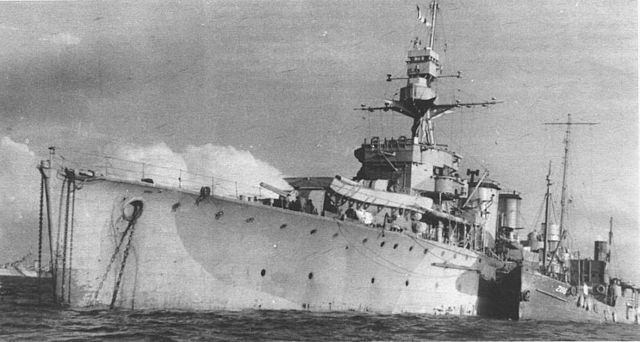
As ORP Dragon, 1944
Interwar carrer
Launched on 29 December 1917, HMS Dragon was not commissioned until 10 August 1918 at Harwich Dockyard under command of Capt. A. H. Allington. She is often credited having fired the last shot of the war at sea, engaging engaged German seaplanes off Heligoland Bight, 9 November 1918. Soon after her short service (the crews trained well until September-October so she really only served properly on wartime patrols in November. After the war, she had the nonor to carry the Prince of Wales, future King Edward VIII, to Canada in August 1919 for his royal tour in the Americas.
Lke her sister ship she was sent to take part in the Russian Civil War off Latvia and Estonia, against the Bolsheviks, also helping the German Freikorps forces, in October-November 1919. On 17 October 1919, HMS Dragon received three shells from a shore battery when supporting German forced off Riga. The impacts cost her nine killed and five wounded. In 1920, as part 1st Light Cruiser Squadron, Atlantic Fleet (Captain O. H. Hawke-Genn in command from March) and for the 1920s at kearge wich just two interruptions for overhauls, on 8 May 1923 and 2 February 1926, both in Chatham’s drydock.
on 1924, she was attached to a representative task force (HMS Hood, Repulse, Delhi, Danae, Dauntless) touring the world. HMS Dragon visited Zanzibar, Ceylon, New Zealand, Fiji, Canada, Jamaica, all as temporary bases during the trip and visited ports in the US coast, the Dutch Antilles and Australia. She was overhauled on 20 December 1928, seeing notably her seaplane hangar dismantled. From 15 November 1929, P. W. Nelles, RCN, took command.
On 22 January 1930, making her post-refit sea trials at Chatham, she became tender to Pembroke, and jumped in and out commission in the 1930s. On 30 May 1933 Noël Coward visited HMS Dragon in Bermuda, coming from SS Roma. By that time, the cruiser was under command of a futre figure of the RN in WW2: Captain Philip Louis Vian, whic interpelled Coward, saying “What the hell are you doing on board this ship?”, but afour finding out who he was, allowing to stay for a cruise on the Pacific side of the Panama canal. Dragon disembarked the famous playwright and then headed for the China Station, and then the America and West Indies station in 1935.
In 1934 she collided with a steamer in Montreal (Quebec, Canada). Captain Frederic Wake-Walker was blamed for incompetence, as Canadian courts found him liable for the collision. In late October 1936, HMS Dragon tried to help the straddled Spanish cruise liner Cristobal Colon north of Bermuda, which failed. On 16 July 1937 she was at home with a small reserve crew, actibg as a tender to HMS Cardiff. Before the war strated she was part of the Reserve Fleet in The Nore.
HMS Dragon in WW2
HMS Dragon was still “in her juice” when World War II broke out, and was not sent on the frotnline, attached instead to the 7th Cruiser Squadron -Northern Patrol- operating in the Shetland area. In November 1939, she was part of the wild hunt against the Admiral Graf Spee. In February 1940, she operated briefly in the Mediterranean and and was back to the Atlantic fleet. On 16 September 1940 she looked for Vichy French vessels after Operation Catapult in August, and captured the French steamer Touareg. On 23 September, she took part in Operation Menace against the Vichy-held port of Dakar, and with HMS Inglefield and Foresight, she spotted and sank the Vichy French submarine Persée. She also shelled the port and military installations. She was later based in Freetown, South Africa, in order to spot and engage the German cruiser Admiral Scheer in December 1940.
1941 saw little action but a routine of escort duties in the Atlantic. Until November, she escorted various convoys. The end of the year saw tension rising in Asia and she was en route on 7 december, assigned to the American-British-Dutch-Australian (ABDA) Command forces. She escorted convoys to Singapore, and was the last ship leaving the city before it fell. On 20 January 1942, she joined the Western task force (Java Sea) which HMAS Hobart, HMS Danae and the destroyers Tenedos and Scout.
After the fall of Java, she teamed with HMS Caledon and HNLMS Jacob van Heemskerck patrolling off Ceylon. In May 1942 she was assigned to the Operation against Madagascar (Operation Ironclad) and in June her crew was reduced, sent to other units, while she sailed back home for a major overhaul, but attached to various convoys and transtiting via Cape Town, Chatham and Durban unti; she arrived in Liverpool by September 1942.
As ORP Dragon:
On 15 January 1943, she was handed over to the Polish Navy as ORP Dragon. She was modernized as planned however soon after this, in Birkenhead shipyard, refitted with new electric power unit to cope with the installation of a radar and modern AA armament. She went out of drydock on 23 August 1943, satiling to Scapa Flow to start training with her Polish craw. Her duties however remained essentially the same: She took part in Atlantic convoy escort missions. On 20 February 1944 however she was to join her first norther Murmansk-bound convoy with HMS Berwick and Jamaica, escorting JW.57 convoy part. For the incoming Battle of Normandy she trained extensively and was prepared, and on 2 June, was attached to a local bombardment fleet comprising also HMS Ramillies, Warspite, Mauritius, Frobisher, Arethusa, Danae.
In Operation Neptune, on June, 6, she was off Sword Beach, and shelled German shore batteries at Colleville-sur-Orne and Trouville, from just 4 kilometres. A German 105 mm (4 in) from one of these shore batteries made a near-miss which wounded three sailors. Ramillies and Roberts eventually silenced the battery. By the evening she was ordered in front of Juno Beach to support the advance inland. On the 7th, she shelled German positions on demand around Caen. On the 8th she suffered a communication system failure, repaired at night, allowing her to resume directed fire on the German 21st Panzer Division near Varaville. On the 9th she engaged the shore battery at Houlgate, and was back to Portsmouth to resupply. Back in action on 12-17 June she targeted German positions around Caen, Gouneville, Lébisey and Varaville and was near-missed by torpedoes from an unknown German submarine. On 18 June she escorted home HMS Nelson, damaged by a mine.
Luck was about to turn for the cruiser. ORP Dragon on 7 July was to take position for support off Caen, part of the artillery preparations before capturing the besieged city. At 5:40 am while stationary, she was hit by a German Neger manned torpedo (probable pilots: Walther Gerhold or Midshipman Potthast). This was one of the rare success of this desperate wepaon. The explosion killed 26 men and th ship was crippled, but seemingly still possibly to be repaired. The explosion caused a fire in the 3rd magazine, soon extinguished by opening all valves and filling the compartment with seawater. The the 3rd engine room was also hit and evacuated.
ORP Dragon started to sink on her port side until her list reached 9°, but this was partly stabilized when the captain ordered all main guns to be trained to starboard. Later as 11 more sailors died of their wounds, the list was stabilized and ORP Dragon was able to sit on shallows, waiting the ebb tide to steam again. Meanwhile flooded engine room were pumped out, but a damage party found the hull was pierced across two sections with a gash of about 5 metres (16 ft) by 15 metres (49 ft). The local command ordered the ship to be abandoned and on 10 July the crew was evacuated by USS LST-494, back to England. The remaining rump crew dismantled the armament and 16 July the cruiser was officially decommissioned, towed to Mulberry “B” near Courseulles on 20 July and scuttled as an artificial breakwater.
 HMS Delhi
HMS Delhi
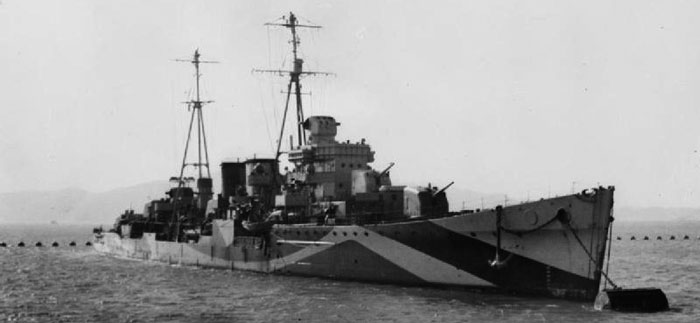
HMS Delhi, 11 April 1942
Delhi’s interwar years
HMS Delhi was the last of the first batch. She was launched on 23 August 1918 and Commissioned on June 1919. After completion and her sea trials she was assigned to the 1st Light Cruiser Squadron, Atlantic Fleet, and sent in the Baltic to support the multinational intervention in favor of White Russians. Back home, she spent the years 1920-23 with the Atlantic Fleet before being chosen with the other cruisers of the first group to be part of the “Special Service Squadron” touring the world. When back in December 1924, she was paid off, joined the 1st Cruiser Squadron, Mediterranean Fleet (January 1925), was sent in the China Station for anti-piracy patrols and back to the Mediterranean, followed by a refit in Malta’s drydock.
On 15 November 1925, Delhi left Malta with HMAS Sydney and Adelaide to take part in the “southern skies” goodwill cruise touring Ceylon, Fremantle, Hobart, Jervis Bay, and Sydney, and then Christchurch and Wellington. later she was based in the Caribbean station, 8th Cruiser Squadron (America and West Indies). She acted against local insurgents on Dominica, landing Royal Marines. She was flagship of the 8th Cruiser Squadron during thse operations and later operate with HMS Hood and Repulse for a West Indies tour with the brand new heavy cruisers HMS Norfolk and Dorsetshire. In 1933 she was recalled to the 3rd Cruiser Squadron, Mediterranean Fleet, Based at Malta, under command of Captain Farquhar Smith, RAN. As the Spanish Civil War broke out in 1936, HMS Delhi picked up refugees at Palma de Mallorca, Barcelona and Valencia and even engaged by the Nationalist heavy cruiser Canarias, framed and near-straddled in the process, until Canarias broke down its attempt to prey on the Republican port. Delhu was also repeteadly attacked by Nationalist aviation, only suffering near-misses.
Delhi’s WW2 campaign
In September 1939, HMS Delhi just came out reserve, being overhaul soon before and fully crewed, loaded and supplied, she joined the 11th Cruiser Squadron, at Scapa Flow. Delhi was out in the North Sea when HMS Royal Oak was sunk. She resumed her blockading patrols and on the Iceland-Faroes Gap she spotted and captured the Greman freighter Rheingold. She also assisted another vessl capturing and scuttling of the blockade-runner Mecklenburg, by gunfire.
Out of Scapa again on 23 November 1939, she met HMS Caledon, Cardiff, Newcastle plus the merchant cruiser Rawalpindi during a convoy patrol, but Rawalpindi was separated from the escort, sent away by another spotting, staying with the convoy and making a valiant last stand while facing the Scharnhorst and Gneisenau. Newcastle and Delhi shadowed both battleships as soon as they were spotted, allowing a trap to be formed with the rapid approach of the Home Fleet. German Admiral Marschall eventually withdrew, evading the chase in bad weather to Wilhelmshaven.
Back to Malta, Mediterranean, in March 1940, HMS Delhi was part of Force H, and took part in patrols against Vichy shipping, and Italian forces between Italy and North Africa. She was later assigned to Force M, Freetown, West Africa to patrol and escort convoys through the South Atlantic. Delhi and Dragon took part together in Operation Menace the attack on Vichy-held Dakar, shelling French positions and shore batteries, shipping, and patrolling waters. She went on afterwards to her routine of trade protection in the South Atlantic.
In May-December 1941, HMS Delhi was overhauled in Brooklyn NyD as British Yards were at full capacity. She was refitted as an anti-aircraft cruiser, her main feature being the replacement of her main artillery by five 5-inch/38 calibre guns originally intended USS Edison, transferred to HMS Delhi on the direct instructions from President F.D.Roosevelt, notably as a good will gesture to Britain. With this modern, new dual purpose main armament quite unique at the time, she took part in all Mediterranean Amphibious Operations that followed in 1944, in shore bombardment and AA support. She operated off Algiers, Sicily, Salerno and Anzio. Starting with Operation Totch, on 20 November 1942, she was damaged by enemy action, in Algiers Bay, attacked by Italian aircraft. She los her prow in an explosion, killing two crewmen and wounding many more. This damage was serious enough for her to be sent back to UK for repairs, taking her out of action until April 1943.
On 3 September 1943, while preparing before the Salerno landing operation (Operation Avalanche), she collided with HMS Uganda in the Straits of Messina, whilst laying a smokescreen. The damage was light enough to be repaired at sea so she could support the landings and provide AA cover. Delhi took later part also in Operation Shingle, and later to Operation Dragoon in the South of France. She remained afterwards in the Mediterranean, patrolling along the Italian coast, and later Adriatic. This was in this occasion that she was on 12 February 1945 attacked by German explosive motorboats in Split, Croatia whereas the the German surrender took place three months earlier on her very decks. Instead of hitting the cruiser, these devices hit the AA Landing Craft LCF-8 alongside, but the blast nevertheless damaged her rudder, dislodged a propeller shaft bracket. Back to Britain, she was laid up and sold on 22 January 1948, BU at Cashmore, Newport, Wales, in April 1948.
 HMS Diomede
HMS Diomede
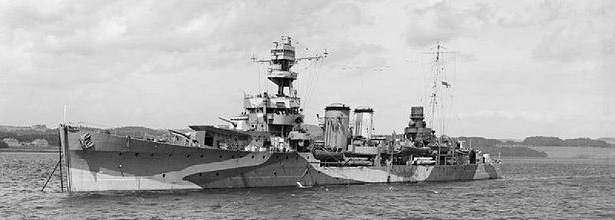
HMS DIOMEDE, 12 June 1943
HMS Diomede, laid down in Vickers Armstrong (Barrow-in-Furness) by mid-1918. After launch, in 1919, work was suspended as per post-war reassessments. She was untilamtely greenlight for completion, which took place on 22 Feb. 1922 towed to the Royal Dockyard in Portsmouth. HMS Diomede was the only one to have a on “A” a fully enclosed, experimental 6-inch turret mounting. HMS Enteprise had the same, but twin. The admiralty also discussed to converted her as a royal yacht but this went to nil.
After commission with the 5th Light Cruiser Squadron, she was based in the China Station from 1922 to 1925. At the time, she was transferred to the New Zealand Division at Devonport, until 1935; She received in between an overhaul and refit 1929-1930. Aprt her training routine she assisted in 1931 Napier in New Zealand after the Hawkes Bay earthquake. She supplied medical personnel, equipment, guards and firemen with HMS Dunedin. She also assisted the damaged sloop Veronica to Auckland. This was under Commander Victor Crutchley, a future WW2 Pacific Campaign admiral.
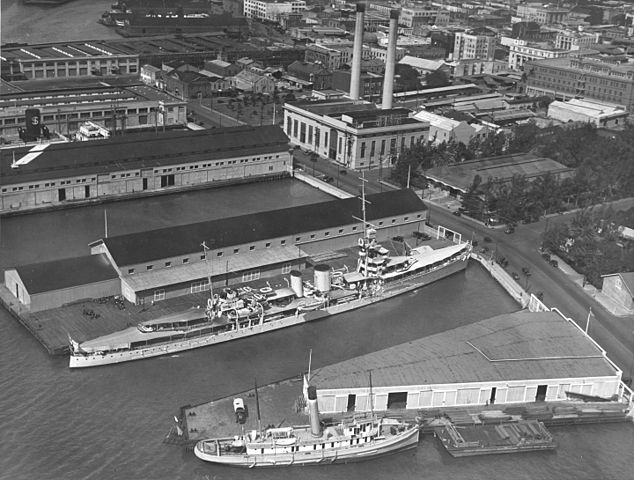
HMS Dunedin, Honolulu 11 February 1927
Diomede and Dunedin only departed the New Zealand Division when notified to their replacement by recent Leander-class cruisers. In 1935, HMS Diomede departed for Britain and was paid off, placed in reserve upon arrival. She was reactivated during the Abyssinian Crisis, assigned to the 4th Light Cruiser Squadron, East Indies (Base Aden) if receiving an order from the Government to blockade the Italians. HMS Achilles replaced her on 31 March 1936 and until 1939 she was replaced in reserve, acting however in between as troop ship.
HMS Diomede was reactivated and on 3 September 1939 was assigned to the 7th Cruiser Squadron, Home Fleet, tasked of the Northern Patrol, a blockading force. Later she was assigned to the 8th Cruiser Squadron on the America and West Indies Station, for shipping protection notably. In July 1940, the degrading situation in the Mediterranean forced the 7th Cruiser Squadron to this theater. On 8 December 1940 she spotted and caught the German blockade runner Idarwald from Tampico off Mexico. The freighter was scuttled off Cabo Corrientes in Cuba, observed by US destroyer USS Sturtevant. She was back in the Mediterranean in 1941, participating in convoy escorts, sometimes attacked but never seriously threatened.
In early 1942, HMS Diomede was reaffected to the 9th Cruiser Squadron, South Atlantic & West African Squadron. An assessment of her general condition led to her early retirement: In June, she sailed to Rosyth Dockyard, to be converted from 22 July 1942 to 24 September 1943, into a training ship, with new accomodations and reduced armament. In 1944, she was placed in reserve and on 5 April 1946, sold for scrap (Arnott Young of Dalmuir), BU in May 1946.
 HMS Dunedin
HMS Dunedin
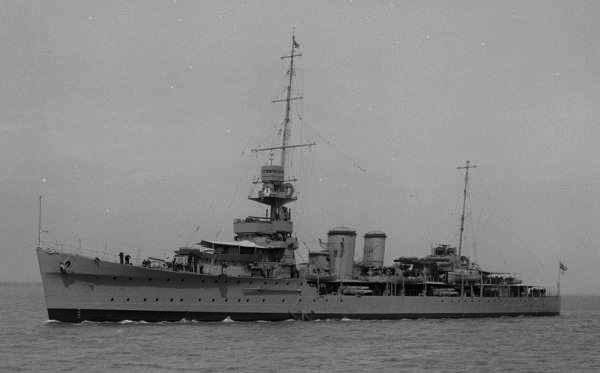
HMS Dunedin in the 1920s, Alan Green Coll.
HMS Dunedin was laid down at Armstrong Withworth yards on 5 November 1917, launched on 19 November 1918 and completed at Hawthorn Leslie and Company, and then Commissioned on 13 September 1919. As a cruiser of the second group, she had a raised forecastle and a trawler bow.
She basically had the same service records as HMS Diomede, as she served alongside in the same 5th Light Cruiser Squadron in China and New Zealand, 4th station at home, and in October 1920 assured protection of the unloading of munitions intended for Poland, at Danzig, with three other ships. In 1931 like he sister she carried out an humanitarian mission to the devastated twon of Napier in New Zealand after an earthquake, alongside the sloop Veronica. She was placed in reserve in 1935, but was reactivated in 1939 as the war was looming.
HMS Dunedin’s wartime carrer was short: She patrolled northern waters with the 7th CS, taking part in the hunt for the German battleships Scharnhorst and Gneisenau after the latter sunk the Rawalpindi. In early 1940, HMS Dunedin was in the Caribbean Sea, intercepting the German merchant ship Heidelberg, west of the Windward Passage. Her crew scuttled their own ship before surrendring. Dunedin and the Canadian destroyer HMCS Assiniboine intercepted a few days later the German merchant ship Hannover, near Jamaica. This time the latter was captured intact and was returned to the UK. It was soon decided to convert her into an experimental escort aircraft carrier, HMS Audacity. In July-November 1940, HMS Dunedin and Trinidad blockade Vichy-French Martinique in the western Carribean, notably to avoid three French warships to be back home, notably the aircraft carrier Béarn. Nothing much happened in December 1940 to June 1941 but other patrol and escort missions in the Atlantic.
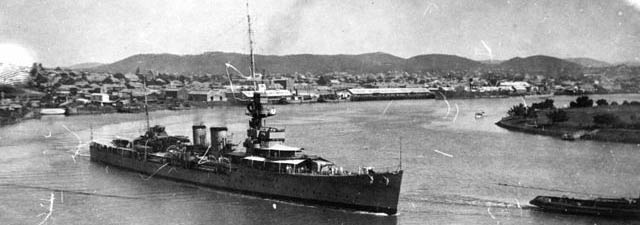
HMS Dunedin in Australia, interwar
On 15 June 1941, HMS Dunedin captured the German tanker Lothringen and her boarding party spotted and captured classified Enigma cipher machines, brought back to the Admiralty promptly. Lothringen was reconditioned by the Royal Navy later as the fleet oiler HMS Empire Salvage. Dunedin also hunted for Vichy French vessels and captured along the way the liner Ville de Rouen off Natal, the Ville de Tamatave east of the Saint Paul’s Rocks, and the sloop D’Entrecasteaux. However, while she was operating in the Central Atlantic Ocean, still off St. Paul’s Rocks (NE Recife, Brazil), on 24 November 1941, she was spotted and ambushed at 15:26 hours taking tow torpedoes out of a full volley of six from U-124. The impact was enough to flooded her massively and so quickly she capsized and sunk, leaving just thosed in the superstructures and deck alive, four officers and 63 men. All the rest perished, went to the bottom. The survivors derived from some time before being recued.
 HMS Despatch
HMS Despatch
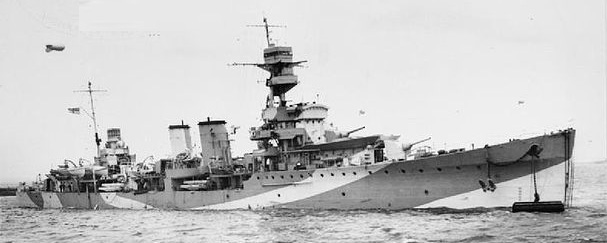
HMS Despatch 22 July 1942
The last ever cruiser or RN ship of that name was laid down by Fairfield Shipbuilding and Engineering Company, on 8 July 1918, launched on 24 September 1919, and then towed to Chatham Dockyard for completion on 15 June 1922, commissioned on 2 June. She had an uneventful interwar carreer, alternating between stations in China, American and Carribean, and home waters. She was overhauled twice in between and was placed in reserve in 1936, reactivated in 1939 and fully recommissioned when the war broke out.
HMS Despatch had possibly one of the most “cushy” career of all Britush cruisers, at first operating in the South Atlantic in late 1939, capturing the German freighter SS Düsseldorf and later the merchant ship Troja. The latter scuttled herself however and could not be captured. She was sent in the Mediterranean in the summer of 1940 to bolster the RN there after Italy went at war. She escorted convoys from late 1940, but took part in Operation White (An aircraft reinforcement convoy to Malta, 17 November, escorting HMS Argus) and later the Battle of Cape Spartivento as part of Force “B”, sub-unit of Force “H” (base Gibraltar) which was not fired upon, nor had the occasion to fire either. Force H at the time comprised HMS Ark Royal, HMS Valiant and Resolution, HMS Arethusa, Delhi, Enterprise and the destroyers HMS Faulknor, Forester, Foresight, Foxhound, Fearless, Escapade, Active and Wrestler.
On 18 February 1943, still operating patrols and escorts in the Mediterranean, at 13.45 hrs HMS Despatch intercepted the Spanish Monte Naranco, sent a boarding party so she was placed with an armed guard aboard and escorted by the Greek destroyer Adrias to Gibraltar. At the end of 1943 she was sent back to UK for an overhaul.
In 1944 she resumed her escort missions, thus time in the Atlantic. In June she was present off the coast of Normandy for action (Commander R.T. White), bringinf artillery support for a week. Later she became the headquarters ship for the Mulberry harbours, anchored at Mulberry ‘B’. She hosted the visit of H.M. King George VI. Specialized as a permament Mulberry harbor HQ Ship all her guns were removed, replaced with sixteen Bofors 40 mm AA, all manned by army gunners (127th Queen’s Light Anti-Aircraft Regiment of the Royal Artillery). She received new acomodations as well. There, she was used to Control traffic, during the building and later exploitation of the Mulberry Harbour at Arromanches.
After this, she was sent back to UK in late 1944 and reduced to reserve in January 1945. She was sold for BU on 5 April 1946 and scrapped by the yards of Arnott Young, Troon, Scotland, on 5 May 1946.
 HMS Durban
HMS Durban

HMS Durban, 8 October 1942
HMS Durban was laid down at Scotts Shipbuilding and Engineering Company, Greenock on January 1918, launched on 29 May 1919, Completed by Devonport Dockyard and Commissioned on 1 November 1921. Initially assigned to the China Station, 5th Light Cruiser Squadron from January 1922 she served there until 1928; By that time she was reassigned and transferred to the America and West Indies Station, in Bermuda. There, she received a new crewman, Prince George, Duke of Kent (fourth son of King George V and Queen Mary), as a watch-keeping Lieutenant.
In 1930, Durban sailed back Britain for a short overhaul, and from 1931, she was assigned to the South Atlantic Division. From December 1933, she was relieved by HMS York and was sent back to home waters, until March 1934, as she was prompted to Gibraltar, and the Mediterranean Fleet, until 1936, but not seeing the start of the Spanish civil war as she was sent before back to UK to be placed in reserve in September 1936.
From September 1939, HMS Durban, fully reactivated a few days prior and now recommissioned, was assigned to the 9th Cruiser Squadron as flagship in the South Atlantic station. Althiugh she played no part in the hunt for Graf Spee in december, from March 1940, she operated in the Indian Ocean. She was later transferred to the Eastern Fleet, Singapore. She became part of the “British Malaysian Force” with two sister ships, Danae and Dauntless.Their task was to intercept German merchant ships operating trying to escape from Dutch East Indies harbours. Durban patrolled off Padang when on 10 November 1940 she received new that the Norwegian tanker Ole Jacob was attacked by the German raider Atlantis on her Ceylon-Sumatra road. The British Malaysian Force (BMF) HQ immediately assembled the fleet, with Durban, Capetown and HMAS Canberra, in addition to the armed merchant cruiser (AMC) HMS Westralia as a hunting group to search for KMS Atlantis. However after several days of searching they were unable to locate the German raider.
In January 1941 HMS Durban and Dragon escorted convoys between Singapore and the Sunda Strait and from February 1941, Durban escorted the ocean liner SS Queen Mary carrying the entire Second Australian Imperial Force troops to reinforce Malaya, in Singapore. In November 1941 she escorted mid-way for her last leg the troopship Zealandia also to Singapore, relieving HMAS Sydney escorting Zealandia mid-way from Fremantle in Australia. She was to spent Christmas 1941 in overhaul, soon interrupted by the attack on pearl Harbor.
In February 1942, Durban was escorting the Eastern Fleet to Java when the Japanese attacked Singapore. She was among the last cruisers here. Japanese bombers soon squared on her, straddled, bombed and damaged by ner-misses before she could leave. On 12 February however she was at sea, with the ASW vessel Kedah, escorting Empire Star and Gorgon out of Singapore. Along the way, her AA crews were jard at work trying to repel successive Japanese air attacks. It went on for four hours of constant raids. Again, the ships were straddled and near-missed, but none were sunk.
on 13 February, the convoy which carried thousands of refugeeds fleeing Singapore at last reached Tandjong Priok, Batavia, to be safely landed. HMS Durban by then hosted Admiral Thomas C. Hart and departed on 16 February to escort another merchantman, Plancius, carrying other Singamore refugees to Colombo. Durban had temporary repairs, due to her battle damage since Singapore. She was seaworthy enough to head for New York (April 1942), entering drydock for full repairs.
HMS Durban went to Britain to be modernized next in Portsmouth in June-August 1942. From then, she was tasked or more escort missions, operating with convoys from Britain to South Africa. On 8 December 1942 however she was grounded in the entrance to Mombasa harbour. Refloating, she was drydocked in Bombay. In February 1943, back to New York NyD for additional repairs she was back in June 1943 to her South Africa station. She was docked at Simonstown, and joined the Eastern Fleet.
By November 1943, she returned to Britain and due to her age, was paid off, into reserve. She was in 1944 one of the old ships selected to be scuttled as breakwater, for the Mulberry constructed to help supplying allied forces during the Battle of Normandy. On 9 June, she was towed in place, then scuttled at the Gooseberry 5 breakwater, off Ouistreham (Seine Bay). The wreck is still there today, 11 metres (36 ft) deep.
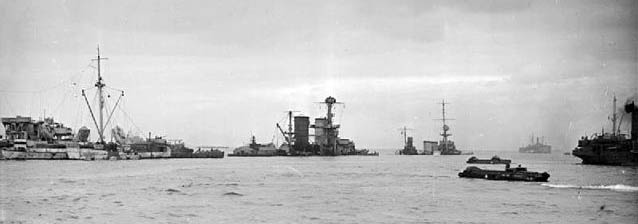
D class ships sunk in the Gooseberry 5 off Ouistreham artificial’s harbour


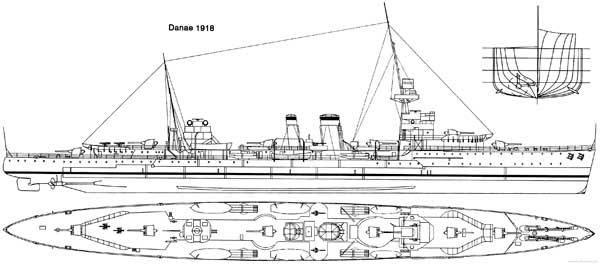
 Latest Facebook Entry -
Latest Facebook Entry -  X(Tweeter) Naval Encyclopedia's deck archive
X(Tweeter) Naval Encyclopedia's deck archive Instagram (@navalencyc)
Instagram (@navalencyc)





 French Navy
French Navy Royal Navy
Royal Navy Russian Navy
Russian Navy Armada Espanola
Armada Espanola Austrian Navy
Austrian Navy K.u.K. Kriegsmarine
K.u.K. Kriegsmarine Dansk Marine
Dansk Marine Nautiko Hellenon
Nautiko Hellenon Koninklije Marine 1870
Koninklije Marine 1870 Marinha do Brasil
Marinha do Brasil Osmanlı Donanması
Osmanlı Donanması Marina Do Peru
Marina Do Peru Marinha do Portugal
Marinha do Portugal Regia Marina 1870
Regia Marina 1870 Nihhon Kaigun 1870
Nihhon Kaigun 1870 Preußische Marine 1870
Preußische Marine 1870 Russkiy Flot 1870
Russkiy Flot 1870 Svenska marinen
Svenska marinen Søværnet
Søværnet Union Navy
Union Navy Confederate Navy
Confederate Navy Armada de Argentina
Armada de Argentina Imperial Chinese Navy
Imperial Chinese Navy Marinha do Portugal
Marinha do Portugal Mexico
Mexico Kaiserliche Marine
Kaiserliche Marine 1898 US Navy
1898 US Navy Sovietskiy Flot
Sovietskiy Flot Royal Canadian Navy
Royal Canadian Navy Royal Australian Navy
Royal Australian Navy RNZN Fleet
RNZN Fleet Chinese Navy 1937
Chinese Navy 1937 Kriegsmarine
Kriegsmarine Chilean Navy
Chilean Navy Danish Navy
Danish Navy Finnish Navy
Finnish Navy Hellenic Navy
Hellenic Navy Polish Navy
Polish Navy Romanian Navy
Romanian Navy Turkish Navy
Turkish Navy Royal Yugoslav Navy
Royal Yugoslav Navy Royal Thai Navy
Royal Thai Navy Minor Navies
Minor Navies Albania
Albania Austria
Austria Belgium
Belgium Columbia
Columbia Costa Rica
Costa Rica Cuba
Cuba Czechoslovakia
Czechoslovakia Dominican Republic
Dominican Republic Haiti
Haiti Hungary
Hungary Honduras
Honduras Estonia
Estonia Iceland
Iceland Eire
Eire Equador
Equador Iran
Iran Iraq
Iraq Latvia
Latvia Liberia
Liberia Lithuania
Lithuania Mandchukuo
Mandchukuo Morocco
Morocco Nicaragua
Nicaragua Persia
Persia San Salvador
San Salvador Sarawak
Sarawak Uruguay
Uruguay Venezuela
Venezuela Zanzibar
Zanzibar Warsaw Pact Navies
Warsaw Pact Navies Bulgaria
Bulgaria Hungary
Hungary

 Bundesmarine
Bundesmarine Dutch Navy
Dutch Navy Hellenic Navy
Hellenic Navy Marina Militare
Marina Militare Yugoslav Navy
Yugoslav Navy Chinese Navy
Chinese Navy Indian Navy
Indian Navy Indonesian Navy
Indonesian Navy JMSDF
JMSDF North Korean Navy
North Korean Navy Pakistani Navy
Pakistani Navy Philippines Navy
Philippines Navy ROKN
ROKN Rep. of Singapore Navy
Rep. of Singapore Navy Taiwanese Navy
Taiwanese Navy IDF Navy
IDF Navy Saudi Navy
Saudi Navy Royal New Zealand Navy
Royal New Zealand Navy Egyptian Navy
Egyptian Navy South African Navy
South African Navy






























 Ukrainian Navy
Ukrainian Navy dbodesign
dbodesign